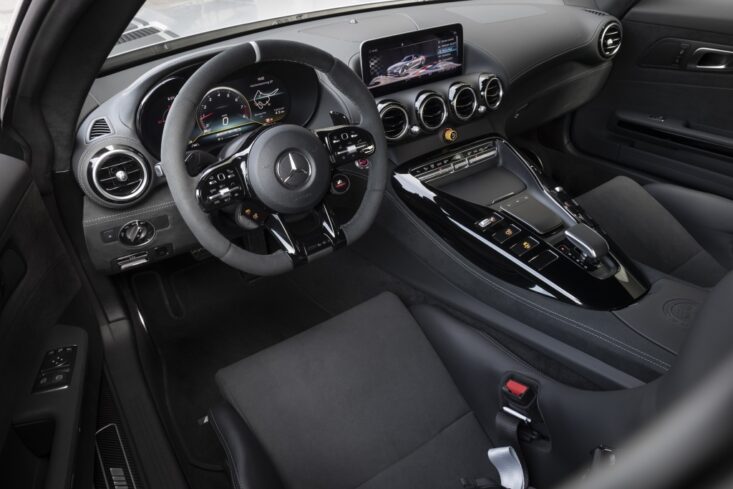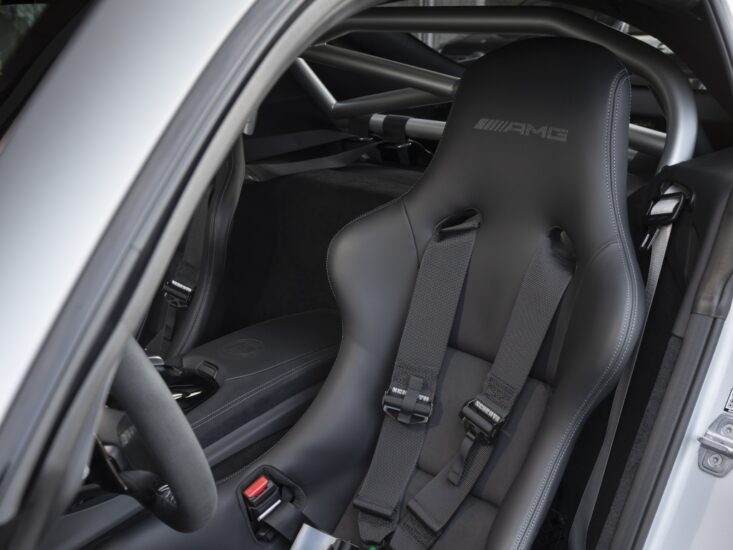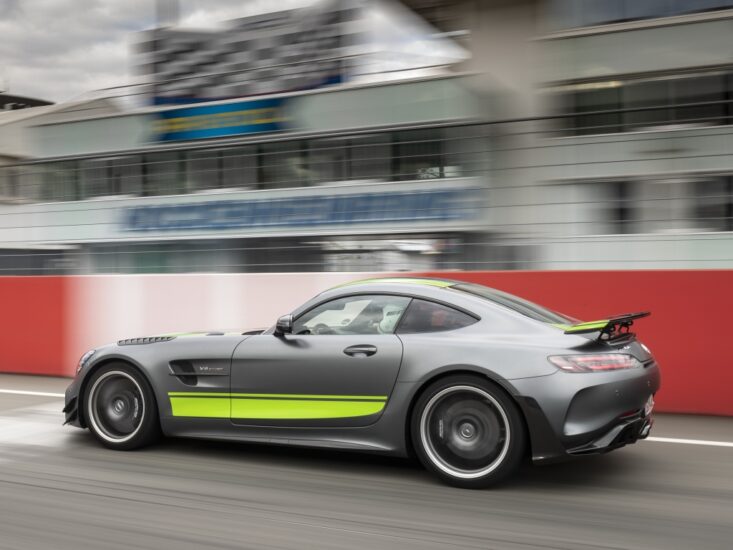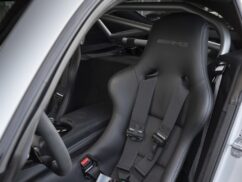First drive: 2020 Mercedes-Benz AMG GT R Pro in Germany
A 585 hp rear-wheel-drive supercar and a rain-soaked Hockenheimring – venue for the German F1 Grand Prix, and a track I’ve never previously been to – are ingredients that pretty much guarantee the day ahead will be anything but dull. Throw in a man named Bernd Schneider, a hard-pedalling five-time German touring car champ, as a pacemaker and you can bet fireworks are in store.
Welcome to the international launch of the Mercedes-AMG GT R Pro – a low-volume (750 units only) track focused special that’s essentially the three-pointed star’s riposte to the likes of the Porsche 911 GT3 RS, Ferrari 488 Pista and Lamborghini Huracan Performante.
Let’s get the key numbers out the way first. Mercedes says the GT R Pro laps the 20.81 km Nurburgring Nordschleife – the default benchmark venue for all lap-time claims – in 7min 4.623sec, which is almost six seconds faster than the ‘standard’ GT R. To put that in perspective, the GT R Pro is still around 8sec slower than the 911 GT3 RS and 12sec adrift of the Huracan Performante at the ’Ring. That said, Merc’s GT family was conceived more as a rapid grand tourer (hence the ‘GT’ moniker) than an out-and-out sportster, which is what the 911, Huracan and 488 are. None of the latter three have their engine up front.

What relevance do these stats have in the real world anyway? Very little, really, as extracting the very last drop of performance from each of these tearaways requires nothing less than a pro driver. This being the case, it’s fitting the new Merc is referred to as the GT R Pro. Away from the racetrack, and in the hands of regular (even skilled) everyday pilots, there’s very little extra to be gained from the substantial price premium you need to shell out for that ‘Pro’ suffix.
All 750 units of the GT R Pro are allegedly pre-sold (Mercedes Middle East says local pricing starts at Dhs 800,000), so clearly there’s a healthy market for such low-volume specials, which is why hypercar purveyors churn them out at regular intervals. Apart from the bragging rights that come via the jaw-dropping lap times served up by these limited-edition models, there’s also the prospect of future collectible status – and therefore soaring resale values – with the passage of time.
But it’s worth pointing out here that the GT R Pro isn’t the be all and end all of the current GT family as the last hurrah will be the upcoming Black Series that will doubtless be snapped up in the blink of an eye. If you’ve got a spare moment, get on Google and look for second-hand examples of the SLS Black Series (built and sold in 2013/14). You’ll be lucky to find one for less than Dhs 1.5 million.

Getting back to the GT R Pro, you can think of it as a carefully fettled version of the standard GT R, rather than a wild upgrade. The 4.0-litre twin-turbo V8 powertrain is exactly as per the former, which means it ekes out the same 585 hp at 6,250 rpm and 700 Nm from 2,100 to 5,500 rpm. This, in turn, translates to a 0-100 kph split of 3.6 seconds and top whack of 318 kph. That’s certainly fast, but not gold standard in today’s hypercar hierarchy.
Where the ‘Pro’ scores over the regular GT R is via its comprehensive aero package, suspension upgrades and weight-saving measures – to make it incrementally quicker around a racetrack, if not in a straight line. The car is underpinned by a new coil-over suspension setup that includes manually adjustable dampers, adjustable front and rear anti-roll bars, and wear-resistant spherical bearings for the rear suspension’s lower and upper wishbones.
As in professional motorsport, the driver can quickly adjust the calibration of the springs and dampers, without requiring any tools to do so. This means you can dial in the settings of the car to suit virtually any track configuration. Again, this isn’t of great value if all you’re doing is driving on public roads, but it’s a cool feature anyway. Likewise, the front axle is fitted with an adjustable torsion bar made of lightweight carbon-fibre, while its counterpart at the rear is made of steel and is likewise adjustable and light due to its hollow tube design. The Pro also gets standard carbon-ceramic brakes that Merc says are better than steel discs at staving off heat-induced fade.

But it’s the eyeball-smacking aero package – which contributes an extra 100 kg of downforce at 250 kph vis-à-vis the GT R – that’s probably got your attention. Up front, there are two ‘flics’ at either side of the car, and their job is to complement the bespoke front splitter in stabilising the GT R Pro at high speeds. They also provide a visual link to Merc’s GT3 and GT4 race cars.
You may have also noticed the louvres in the front fenders that vent the wheelhouses and contribute to reducing front-axle lift. At the rear, a clear-coated carbon-fibre aero element behind the wheel arch on either side rises up vertically almost to the level of the tail lamps. Additional modifications include a revised rear splitter and the inclusion of a ‘Gurney flap’ on the giant carbon-fibre rear spoiler, as well as a new carbon-fibre roof.
If that’s not enough, there’s also the availability of racing stripes in either light green or grey, the former of which is available only on models wearing Selenite Grey Magno paint. But you still feel the urge to go a step further, there’s the optional Track Package, which comprises a fire extinguisher, four-point harness for the driver and passenger, and a bolted steel roll cage, among other goodies.

So that’s the nuts and bolts covered, but it’s seat-of-the-pants feedback that’s more insightful, and this DriveArabia scribe is about to gain some of that because I’ve just strapped into the four-point harness for my first laps around the damp, greasy 4.574 km Hockenheim circuit.
There’s various drive mode settings – Comfort, Sport, Sport+ and Race – you can select from via a switch on the centre console, and there’s also the option of turning off the default ESP (stability control) and then using a yellow twist knob located just below the central air vents to dial up or down how much assistance you want from the electronic nannies. Given how wet the track is, I initially opt to keep ESP on and set out in pursuit of the pace car (an identical GT R Pro, apart from its colour).
Transmitting 700 Nm to the tarmac via two contact patches of rubber can be challenging enough even on dry bitumen, but on the damp surface of the Hockenheim there’s no shortage of twitching and sliding. Turn 7 at Hockenheim is a scarily fast right-hander that’s pretty much a case of hold-your-breath-and-keep-the-throttle-pinned in these sodden conditions. Helping matters is that that the GT R Pro’s steering and chassis telegraph ample feedback, so you can intuit when the limits of adhesion – be it at the front or rear – are about to be exceeded.
I initially keep the seven-speed dual-clutch auto in Manual mode, but later learn it’s much better to let the transmission take charge as it’s far more efficient than any human. In Manual mode I had managed to bounce off the rev limiter – costing momentum – on a number of occasions, but that’s obviously not the case in auto mode as it upshifts at redline. The transmission’s software also has the knack of downshifting exactly the right number of cogs for each corner – even the slow right-handed hairpin following the breathtakingly fast Parabolika, where the GT R Pro hits 260 kph-plus.

As you’d expect in an AMG offering, there’s no shortage of crackling and popping from the exhausts on the overrun and there’s enough torque from the twin-turbo V8 to easily light up the rear tyres out of second- and third-gear corners. A GT3 RS – aided by the weight of the flat-six motor over the rear axle – would serve up greater traction, but the Merc offers greater scope for tail-wagging hooliganism, if that’s your thing.
A final stint behind Schneider as the track begins to dry late in the day provides proof the GT R Pro has limits that few drivers are ever likely to reach, as a supreme amount of commitment is required to exploit the full quota of grip through the faster corners. More familiarity also enables you to tap into the adjustability that’s there – via subtle throttle and braking inputs – enabling you to set up the attitude of the car on corner entry and through them. AMG offerings haven’t always been known for their supreme tactility, but that’s the case here, so even with ESP off and the yellow twist knob set halfway around the dial there isn’t the fear it’ll end in tears.
Would a 911 GT3 RS be quicker around this circuit? More than likely, yes, but the GT R Pro would be within a couple of seconds of the Porsche – a difference that would be tangible only via a stopwatch. From behind the wheel, the Merc feels blindingly fast and stupefyingly grippy, even though today’s damp conditions have prompted AMG’s technical team to fit Pirelli P Zero tyres in lieu of the standard-fit Michelin Pilot Sport Cup 2 rubber, which is super-sticky in dry conditions, but not much good in the wet.
So, is the Mercedes-AMG GT R Pro mildly irrelevant? When you take into account that so few drivers will ever get to sample one, the answer is a resounding yes. But, judged in isolation as a balls-out performance car, it’s fast, engaging and laugh-out-loud fun.
Photos by Mercedes-Benz.







There are no comments. Be the first!